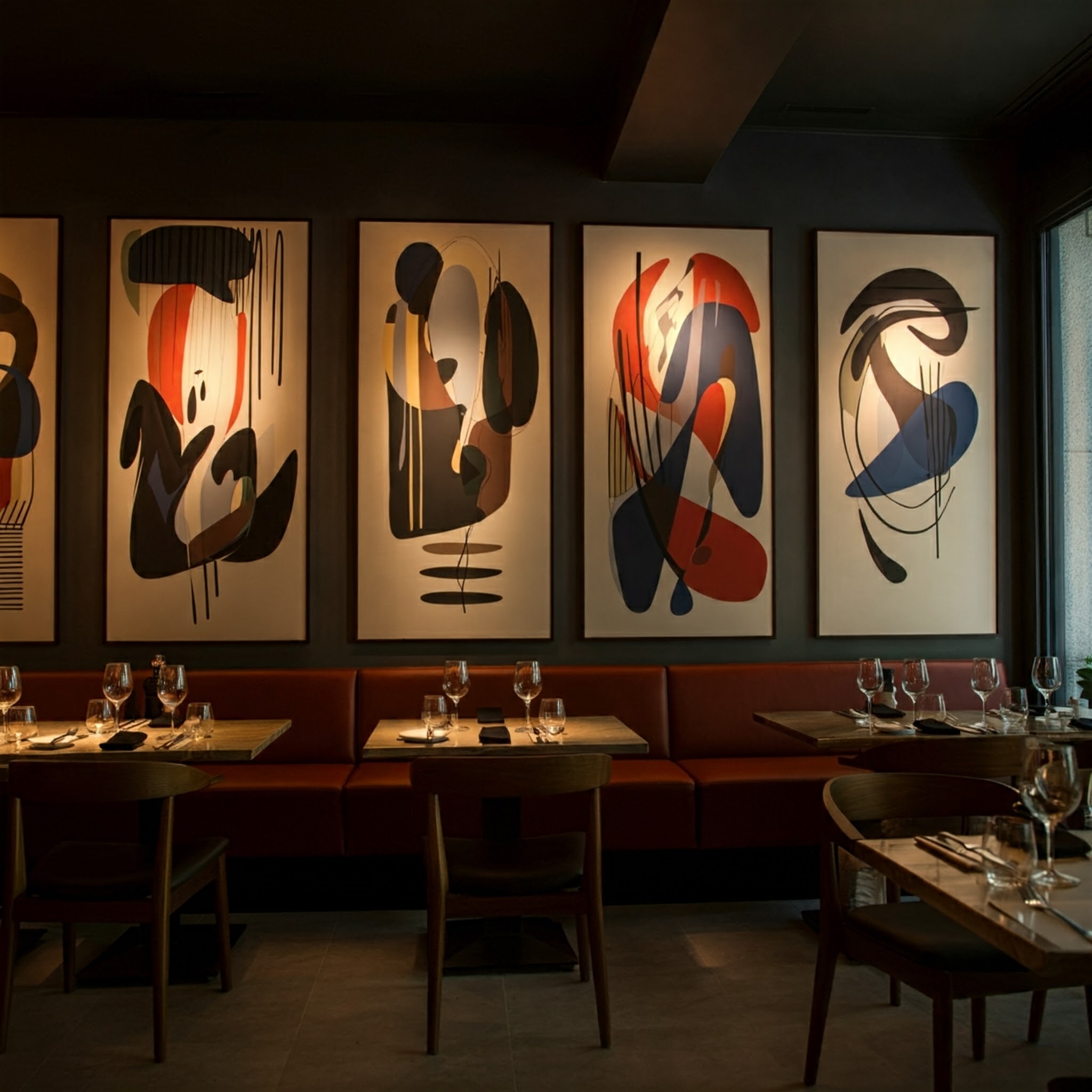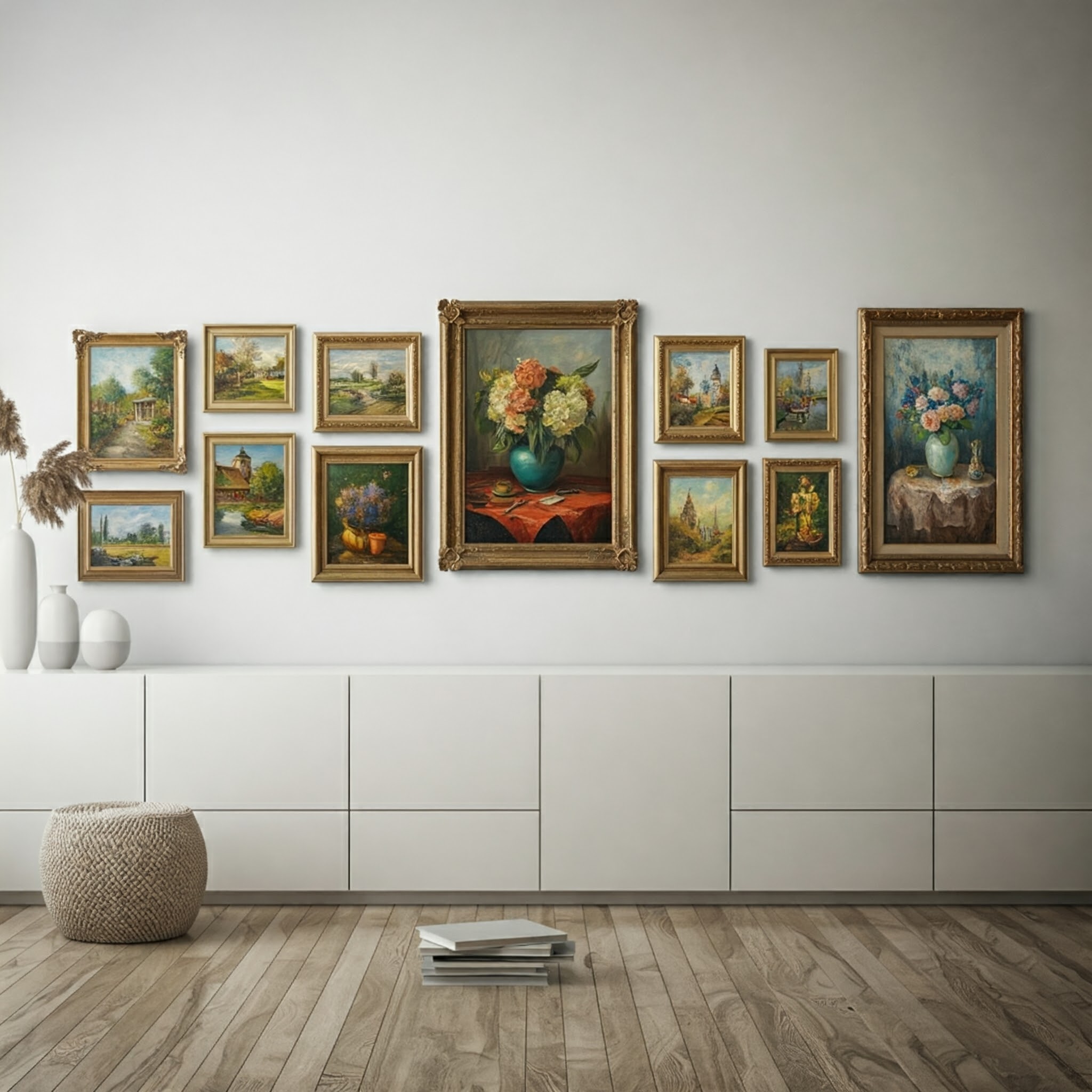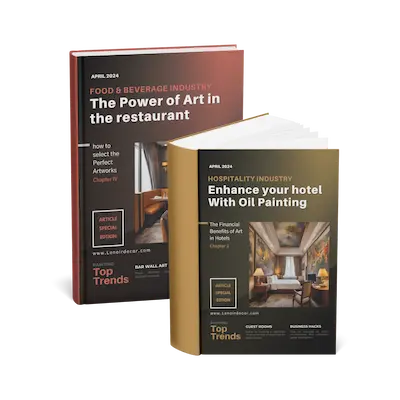I. Introduction
Imagine your restaurant not just as a place to eat but as an immersive experience. A thoughtfully curated gallery wall can transform your wall space, creating a restaurant ambiance that delights your guests and keeps them coming back for more. In the competitive world of the F&B industry, visual appeal is paramount. Restaurant interior design plays a crucial role in shaping the dining experience, and art is a key ingredient in that recipe for success.
Gallery walls have emerged as a popular trend in restaurant interior design, offering a dynamic and captivating way to showcase artwork. By combining art pieces of different sizes and styles, you can create a focal point that enhances the atmosphere and impresses your diners.
This article will guide you on how to create a stunning wall display layout with oil paintings, specifically tailored to elevate your restaurant wall and transform your space. We'll delve into the art of selecting the right pieces, mastering art wall arrangements with varying sizes, and optimizing your design for maximum impact.

II. Why gallery walls for restaurants?
In the competitive culinary landscape, restaurant wall art does more than just fill blank walls. It's a powerful tool for restaurant branding and customer engagement. A well-designed gallery wall goes beyond mere decoration; it tells a story, sets the atmosphere, and enhances the overall dining experience.
Visual storytelling through restaurant wall art can create a deeper connection with your customers. Imagine a farm-to-table restaurant with art pieces showcasing landscapes of local farms or still life oil paintings of seasonal produce. This not only reinforces the restaurant's commitment to fresh, local ingredients but also adds a unique visual element that sparks conversation and enhances the mood.
Different gallery wall ideas can evoke different emotions. A formal dining establishment might opt for a symmetrical wall display layout with classic oil paintings, creating a sophisticated and elegant atmosphere. A casual bistro, on the other hand, might choose an eclectic salon-style arrangement with a mix of contemporary and traditional pieces, fostering a more relaxed and vibrant mood.
For restaurants with limited space, gallery walls offer an excellent space optimization solution. By utilizing vertical space effectively, you can create a visually impactful display without overwhelming the dining area. This is particularly beneficial for smaller cafes or restaurants where every square foot counts.
By strategically incorporating gallery walls into your restaurant interior design, you can elevate the dining experience, strengthen your brand identity, and foster a deeper connection with your customers.

III. Choosing Oil Paintings for Your Gallery Wall
The beauty of a gallery wall lies in the careful selection of artwork. When it comes to oil paintings for restaurants, there's a world of possibilities to explore. Here's how to curate a collection that complements your space and captivates your diners:
Style & Theme
Your restaurant art ideas should align with your overall aesthetic. Is your restaurant modern and minimalist? Classic and elegant? Rustic and charming? Choose pieces of art that reflect your style and enhance the existing restaurant interior design.

- Modern Restaurants: Consider abstract art, bold contemporary pieces, or minimalist works with clean lines and a limited color palette.
- Classic Restaurants: Traditional landscapes, still life paintings, or portraiture can create a timeless and sophisticated ambiance.
- Rustic Restaurants: Look for landscape paintings depicting rural scenes, vintage-inspired still life, or folk art-inspired pieces.
Subject Matter
The subject matter of your oil paintings can further enhance the dining experience.
- Food-Inspired Art: Still life paintings featuring vibrant fruits, vegetables, or culinary delights can stimulate appetite and complement the cuisine.
- Local Scenes: Capture the essence of your location with paintings depicting local landmarks, landscapes, or cultural elements.
- Mood-Evoking Abstracts: Abstract art can evoke a range of emotions. Choose pieces that create a sense of warmth, energy, or tranquility, depending on the desired mood and atmosphere.
Color Palette
The color scheme plays a crucial role in setting the tone.
- Warm Colors: Reds, oranges, and yellows create a cozy and inviting atmosphere.
- Cool Colors: Blues, greens, and purples evoke a sense of calm and sophistication.
- Neutral Colors: Black, white, and gray provide a timeless backdrop and allow the artwork to take center stage.
Framing Options
-
The right frame styles and frame sizes can elevate the style of art and tie the gallery wall together.
- Matching Frames: Create a cohesive look with matching frames in a classic style like black frames or gold one.
- Complementary Frames: Mix and match frames in different styles and finishes that complement each other and the framed artwork.
- Frameless Options: For a contemporary look, consider displaying some oil paintings without frames, especially those with gallery-wrapped edges.
Size and Scale
When selecting oil paintings for your gallery wall, consider the size and scale of both the artwork and your restaurant's walls. A large-scale painting can make a bold statement in a spacious dining area, while a series of smaller paintings might be more suitable for an intimate café. Strive for a harmonious balance between the artwork and the surrounding environment.
Understanding Proportions
The proportions of an oil painting, often expressed as an aspect ratio (the relationship between its width and height), can significantly impact its visual appeal. For instance, a square painting (1:1 aspect ratio) can create a sense of balance and symmetry, while a rectangular painting with a 2:3 aspect ratio might evoke a more classic and elegant feel. Consider the following examples:

By carefully considering these factors, you can curate a collection of oil paintings that not only enhance your restaurant wall but also create a memorable and engaging experience for your diners.
IV. Mastering Gallery Wall Layouts with Sizes
A. Planning the Layout
Before diving into wall decor ideas, meticulous planning is crucial.
- Measure Your Space: Begin by accurately measuring the dimensions of your restaurant wall, taking into account its height and width. Note any architectural features or obstacles, such as windows, doorways, or light fixtures, that may influence your gallery wall layout.
- Furniture Placement: Consider the placement of existing furniture and how it interacts with the intended gallery wall. Ensure adequate space between the bottom of the artwork and any furniture below to avoid a cramped feel and maintain visual balance.
- The 60-75% Rule: A good rule of thumb is to aim for the artwork to cover approximately 60-75% of the furniture's width. This helps to maintain visual balance and ensures that the artwork complements the furniture without overpowering it.
- Visual Mock-up: A visual mock-up is invaluable for visualizing your gallery wall arrangement. Use paper templates to represent your artwork, experimenting with different placements on the floor space or using painter's tape directly on the wall. Digital tools and apps can also assist in creating a virtual gallery wall layout.
B. Working with Different Sizes
Varying the sizes of your oil paintings is key to creating a dynamic and visually engaging gallery wall.
- Visual Interest: A mix of sizes adds depth and dimension, drawing the eye across the gallery wall and preventing monotony.
- Focal Point: Anchor the gallery wall with a larger or more impactful piece as a focal point. Position it slightly off-center to create visual intrigue and balance.
- Balance and Proportion: Achieve harmony by balancing larger oil paintings with smaller ones. Avoid clustering large pieces together, which can overwhelm the space, or scattering too many small pieces, which can appear fragmented.
C. Popular Gallery Wall Layouts with Sizes
Here are some popular gallery wall layout ideas to inspire your restaurant wall decor ideas:

Grid Layout
- What it is: A classic, symmetrical arrangement that creates a clean, organized, and balanced look.
- Best for: Showcasing a collection of similarly sized and themed artwork. Ideal for modern or minimalist restaurants aiming for a sense of order and sophistication.
- Size Recommendation: Aim for consistency in size, such as a collection of 16x20 inch oil paintings. You can introduce subtle variations but maintain overall balance.
- Example: Imagine a grid of black and white photographs, all framed identically, showcasing local landmarks or architectural details.
2. Linear Layout
- What it is: arranging artwork in horizontal or vertical lines, often following the lines of furniture or architectural features like a long banquette or a staircase.
- Best for: Creating a sense of flow and direction. Works well in spaces with strong linear elements.
- Size Recommendation: A larger central piece (such as a 36x48 inch landscape) with smaller pieces on either side creates balance.
- Example: A series of botanical prints arranged vertically above a row of booths, or a horizontal line of framed vintage menus along a hallway.

3. Salon-Style Layout
- What it is: a dynamic and eclectic arrangement with artwork hung close together at varying heights. This creates a sense of energy and visual interest.To better understand the differences between Salon-Style and Grid layouts, consider their contrasting approaches to density, arrangement, and alignment. Salon-style embraces a vibrant, almost chaotic energy, with artworks of various sizes and heights densely packed to fill the wall. Conversely, grid layouts emphasize order and balance, showcasing uniformly sized artworks with consistent spacing and precise alignment. This results in a clean, minimalist aesthetic that differs sharply from the dynamic and unpredictable nature of salon-style displays.
- Best for: creating a maximalist, bohemian, or eclectic vibe. Perfect for restaurants with a lot of personality and a diverse collection of art.
- Size recommendation: embrace variety! Mix and match small, medium, and large oil paintings to create an engaging and layered display.
- Example: A vibrant collection of different sized paintings, prints, and photographs, showcasing diverse subjects and styles, filling a large wall in the dining area.

4. Organic Layout (from the infographic: "Eclectic")
- What it is: a free-flowing, asymmetrical arrangement that feels casual and spontaneous.
- Best for: Creating a relaxed and informal atmosphere. Well-suited for cafes, bistros, or restaurants with a more casual dining experience.
- Size Recommendation: Offers the most freedom. Combine small, medium, and large oil paintings for a balanced yet dynamic look.
- Example: A mix of framed artwork and unframed canvases, arranged in a seemingly random yet balanced manner, creating a sense of effortless style.

D. Spacing and Balance
Achieving visual balance is crucial for a harmonious gallery wall arrangement.
- Consistent Spacing: Maintain consistent spacing between each piece to create visual flow and unity. A general guideline is to leave 2-6 inches between frames, adjusting based on the size and visual weight of the artwork.
- Visual Weight: Consider the visual weight of each piece, with larger, darker, or more intricately framed pieces carrying more weight. Distribute visual weight evenly to prevent the gallery wall from feeling unbalanced.
- Step Back and Assess: Regularly step back to evaluate the overall composition. Assess the visual balance, spacing, and how the gallery wall interacts with the surrounding restaurant interior design. Make adjustments as needed until you achieve a visually pleasing and harmonious arrangement.
E. Larger Spaces and Oversized Wall Art
- In restaurants with expansive walls or high ceilings, embrace the opportunity to incorporate oversized oil paintings. These grand-scale pieces can command attention, create a sense of drama, and serve as stunning focal points. For tall walls, consider vertical orientations to maximize the impact and ensure the artwork fills the space effectively.
By following these design principles and considering the interplay of size, layout, and spacing, you can create a captivating gallery wall that enhances your restaurant's ambiance and leaves a lasting impression on your guests.
V. Custom Oil Paintings: A Unique Touch
While curated collections and existing artwork can certainly enhance your restaurant's ambiance, custom oil paintings offer an unparalleled opportunity to create a truly unique and impactful statement. Commissioning an oil painting allows you to infuse your space with personality, tell your story, and elevate your restaurant branding in a way that no other restaurant art solution can match.
Exclusivity and Personalization
Custom oil paintings for restaurants provide a level of exclusivity and personalization that sets your establishment apart. Original art commissioned specifically for your space ensures that your art gallery walls are unlike any other. It becomes a reflection of your unique vision and a testament to your commitment to creating a memorable dining experience.
Brand Storytelling Through Art
Bespoke artwork can eloquently communicate your restaurant's narrative and brand identity. Here are a few ways custom oil paintings can tell your story:
- Showcase Your Signature Dish: Immortalize your culinary masterpiece in a stunning still life oil painting. Imagine a vibrant depiction of your signature pasta dish or a mouthwatering portrayal of your most popular dessert, enticing guests with visual delights.
- Capture Your Locale: Celebrate your connection to the community by commissioning a landscape painting of the local scenery or a cityscape that captures the essence of your neighborhood. This adds a sense of place and creates a talking point for guests.
- Express Your Brand Values: Translate your restaurant's core values into an abstract oil painting. Whether it's a vibrant composition representing energy and passion or a serene piece embodying tranquility and elegance, abstract art can evoke emotions and reinforce your brand message.
Commissioning a Custom Piece
The process of commissioning an oil painting is a collaborative journey. Here's a simplified guide:
Find an Artist: Seek out artists whose style resonates with your vision. Browse online portfolios, visit local galleries, or seek recommendations from art consultants.
Discuss Your Ideas: Clearly communicate your vision to the artist, including the desired subject matter, style, size, and color palette. Provide inspiration images and discuss your restaurant's brand identity.
Provide Feedback: Maintain open communication with the artist throughout the creation process. Offer feedback on sketches and work-in-progress photos to ensure the final piece aligns with your expectations.
In Conclusion
Ready to transform your restaurant wall with the power of original art? Explore our custom affordable wall art services and discover how we can help you create a unique and unforgettable dining experience. Contact us today for a free consultation, and let's bring your vision to life.
By investing in decor pieces like custom oil paintings, you're not just acquiring artwork; you're investing in a powerful storytelling tool, a brand ambassador, and a unique element that will set your restaurant apart in the competitive culinary landscape.






